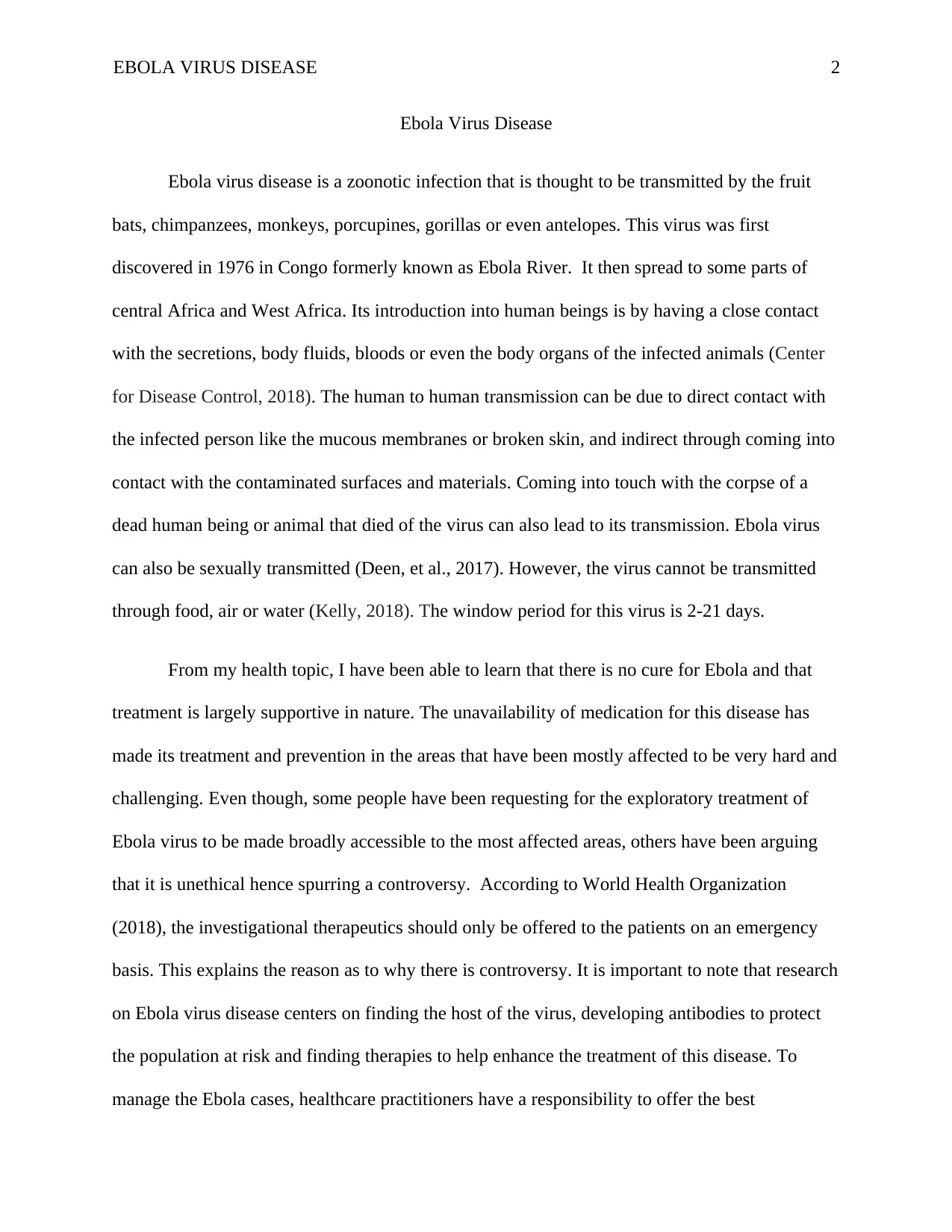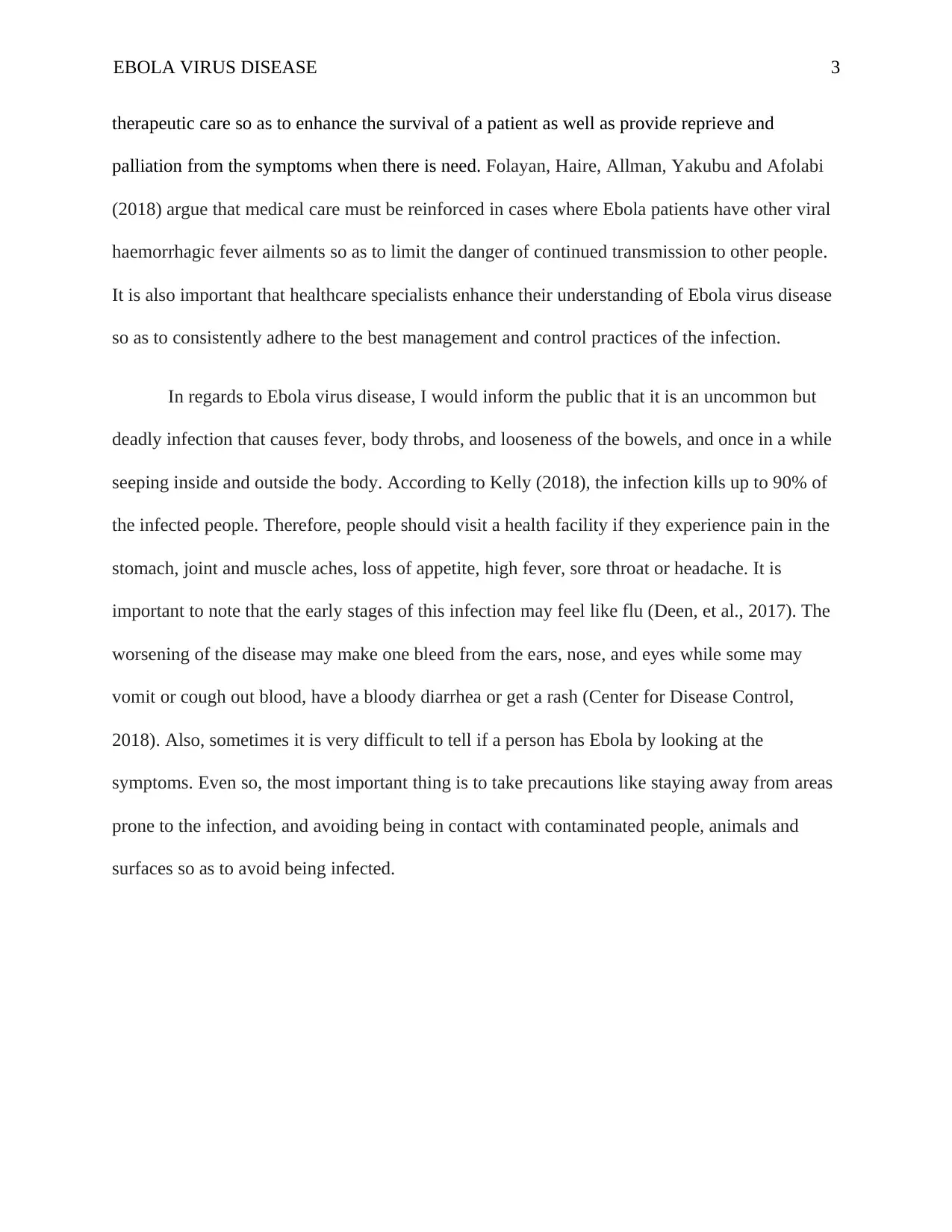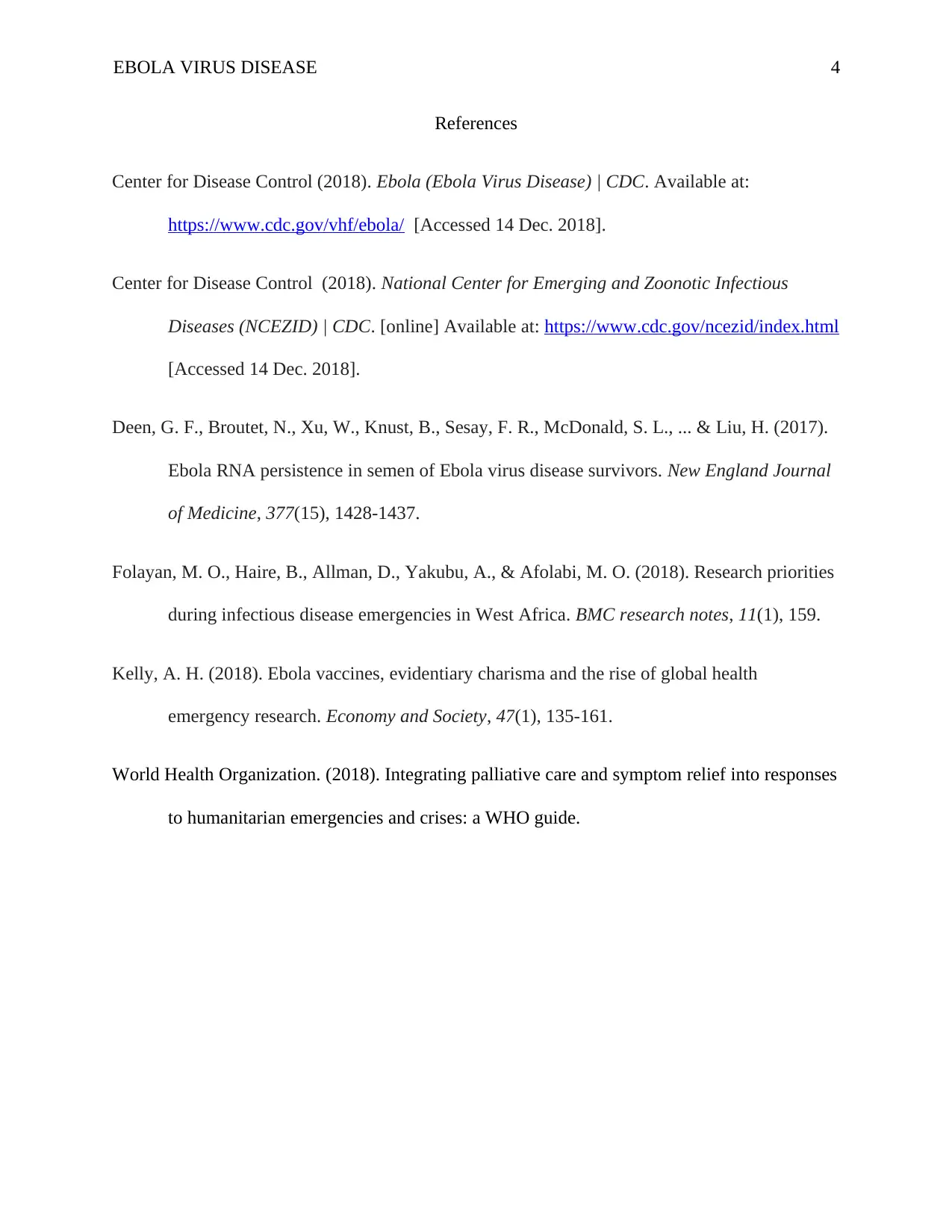Ebola Virus Disease: Transmission Routes, Symptoms, and Management
VerifiedAdded on 2023/05/27
|4
|972
|346
Report
AI Summary
This report provides an overview of Ebola Virus Disease, a zoonotic infection primarily transmitted through contact with infected animals or their fluids. First discovered in 1976, the virus has spread across parts of Central and West Africa. Human-to-human transmission occurs through direct contact with infected individuals or contaminated surfaces, including corpses. Symptoms range from fever and body aches to severe internal and external bleeding. The report addresses the controversy surrounding investigational treatments, emphasizing the importance of supportive care and symptom relief. It also highlights the need for ongoing research into the virus's host and potential therapies. The public is advised to take precautions, such as avoiding contact with potentially infected areas and individuals, and to seek immediate medical attention if symptoms arise.

Running head: EBOLA VIRUS DISEASE 1
Ebola Virus Disease
Name
Institution
Ebola Virus Disease
Name
Institution
Paraphrase This Document
Need a fresh take? Get an instant paraphrase of this document with our AI Paraphraser

EBOLA VIRUS DISEASE 2
Ebola Virus Disease
Ebola virus disease is a zoonotic infection that is thought to be transmitted by the fruit
bats, chimpanzees, monkeys, porcupines, gorillas or even antelopes. This virus was first
discovered in 1976 in Congo formerly known as Ebola River. It then spread to some parts of
central Africa and West Africa. Its introduction into human beings is by having a close contact
with the secretions, body fluids, bloods or even the body organs of the infected animals (Center
for Disease Control, 2018). The human to human transmission can be due to direct contact with
the infected person like the mucous membranes or broken skin, and indirect through coming into
contact with the contaminated surfaces and materials. Coming into touch with the corpse of a
dead human being or animal that died of the virus can also lead to its transmission. Ebola virus
can also be sexually transmitted (Deen, et al., 2017). However, the virus cannot be transmitted
through food, air or water (Kelly, 2018). The window period for this virus is 2-21 days.
From my health topic, I have been able to learn that there is no cure for Ebola and that
treatment is largely supportive in nature. The unavailability of medication for this disease has
made its treatment and prevention in the areas that have been mostly affected to be very hard and
challenging. Even though, some people have been requesting for the exploratory treatment of
Ebola virus to be made broadly accessible to the most affected areas, others have been arguing
that it is unethical hence spurring a controversy. According to World Health Organization
(2018), the investigational therapeutics should only be offered to the patients on an emergency
basis. This explains the reason as to why there is controversy. It is important to note that research
on Ebola virus disease centers on finding the host of the virus, developing antibodies to protect
the population at risk and finding therapies to help enhance the treatment of this disease. To
manage the Ebola cases, healthcare practitioners have a responsibility to offer the best
Ebola Virus Disease
Ebola virus disease is a zoonotic infection that is thought to be transmitted by the fruit
bats, chimpanzees, monkeys, porcupines, gorillas or even antelopes. This virus was first
discovered in 1976 in Congo formerly known as Ebola River. It then spread to some parts of
central Africa and West Africa. Its introduction into human beings is by having a close contact
with the secretions, body fluids, bloods or even the body organs of the infected animals (Center
for Disease Control, 2018). The human to human transmission can be due to direct contact with
the infected person like the mucous membranes or broken skin, and indirect through coming into
contact with the contaminated surfaces and materials. Coming into touch with the corpse of a
dead human being or animal that died of the virus can also lead to its transmission. Ebola virus
can also be sexually transmitted (Deen, et al., 2017). However, the virus cannot be transmitted
through food, air or water (Kelly, 2018). The window period for this virus is 2-21 days.
From my health topic, I have been able to learn that there is no cure for Ebola and that
treatment is largely supportive in nature. The unavailability of medication for this disease has
made its treatment and prevention in the areas that have been mostly affected to be very hard and
challenging. Even though, some people have been requesting for the exploratory treatment of
Ebola virus to be made broadly accessible to the most affected areas, others have been arguing
that it is unethical hence spurring a controversy. According to World Health Organization
(2018), the investigational therapeutics should only be offered to the patients on an emergency
basis. This explains the reason as to why there is controversy. It is important to note that research
on Ebola virus disease centers on finding the host of the virus, developing antibodies to protect
the population at risk and finding therapies to help enhance the treatment of this disease. To
manage the Ebola cases, healthcare practitioners have a responsibility to offer the best

EBOLA VIRUS DISEASE 3
therapeutic care so as to enhance the survival of a patient as well as provide reprieve and
palliation from the symptoms when there is need. Folayan, Haire, Allman, Yakubu and Afolabi
(2018) argue that medical care must be reinforced in cases where Ebola patients have other viral
haemorrhagic fever ailments so as to limit the danger of continued transmission to other people.
It is also important that healthcare specialists enhance their understanding of Ebola virus disease
so as to consistently adhere to the best management and control practices of the infection.
In regards to Ebola virus disease, I would inform the public that it is an uncommon but
deadly infection that causes fever, body throbs, and looseness of the bowels, and once in a while
seeping inside and outside the body. According to Kelly (2018), the infection kills up to 90% of
the infected people. Therefore, people should visit a health facility if they experience pain in the
stomach, joint and muscle aches, loss of appetite, high fever, sore throat or headache. It is
important to note that the early stages of this infection may feel like flu (Deen, et al., 2017). The
worsening of the disease may make one bleed from the ears, nose, and eyes while some may
vomit or cough out blood, have a bloody diarrhea or get a rash (Center for Disease Control,
2018). Also, sometimes it is very difficult to tell if a person has Ebola by looking at the
symptoms. Even so, the most important thing is to take precautions like staying away from areas
prone to the infection, and avoiding being in contact with contaminated people, animals and
surfaces so as to avoid being infected.
therapeutic care so as to enhance the survival of a patient as well as provide reprieve and
palliation from the symptoms when there is need. Folayan, Haire, Allman, Yakubu and Afolabi
(2018) argue that medical care must be reinforced in cases where Ebola patients have other viral
haemorrhagic fever ailments so as to limit the danger of continued transmission to other people.
It is also important that healthcare specialists enhance their understanding of Ebola virus disease
so as to consistently adhere to the best management and control practices of the infection.
In regards to Ebola virus disease, I would inform the public that it is an uncommon but
deadly infection that causes fever, body throbs, and looseness of the bowels, and once in a while
seeping inside and outside the body. According to Kelly (2018), the infection kills up to 90% of
the infected people. Therefore, people should visit a health facility if they experience pain in the
stomach, joint and muscle aches, loss of appetite, high fever, sore throat or headache. It is
important to note that the early stages of this infection may feel like flu (Deen, et al., 2017). The
worsening of the disease may make one bleed from the ears, nose, and eyes while some may
vomit or cough out blood, have a bloody diarrhea or get a rash (Center for Disease Control,
2018). Also, sometimes it is very difficult to tell if a person has Ebola by looking at the
symptoms. Even so, the most important thing is to take precautions like staying away from areas
prone to the infection, and avoiding being in contact with contaminated people, animals and
surfaces so as to avoid being infected.
⊘ This is a preview!⊘
Do you want full access?
Subscribe today to unlock all pages.

Trusted by 1+ million students worldwide

EBOLA VIRUS DISEASE 4
References
Center for Disease Control (2018). Ebola (Ebola Virus Disease) | CDC. Available at:
https://www.cdc.gov/vhf/ebola/ [Accessed 14 Dec. 2018].
Center for Disease Control (2018). National Center for Emerging and Zoonotic Infectious
Diseases (NCEZID) | CDC. [online] Available at: https://www.cdc.gov/ncezid/index.html
[Accessed 14 Dec. 2018].
Deen, G. F., Broutet, N., Xu, W., Knust, B., Sesay, F. R., McDonald, S. L., ... & Liu, H. (2017).
Ebola RNA persistence in semen of Ebola virus disease survivors. New England Journal
of Medicine, 377(15), 1428-1437.
Folayan, M. O., Haire, B., Allman, D., Yakubu, A., & Afolabi, M. O. (2018). Research priorities
during infectious disease emergencies in West Africa. BMC research notes, 11(1), 159.
Kelly, A. H. (2018). Ebola vaccines, evidentiary charisma and the rise of global health
emergency research. Economy and Society, 47(1), 135-161.
World Health Organization. (2018). Integrating palliative care and symptom relief into responses
to humanitarian emergencies and crises: a WHO guide.
References
Center for Disease Control (2018). Ebola (Ebola Virus Disease) | CDC. Available at:
https://www.cdc.gov/vhf/ebola/ [Accessed 14 Dec. 2018].
Center for Disease Control (2018). National Center for Emerging and Zoonotic Infectious
Diseases (NCEZID) | CDC. [online] Available at: https://www.cdc.gov/ncezid/index.html
[Accessed 14 Dec. 2018].
Deen, G. F., Broutet, N., Xu, W., Knust, B., Sesay, F. R., McDonald, S. L., ... & Liu, H. (2017).
Ebola RNA persistence in semen of Ebola virus disease survivors. New England Journal
of Medicine, 377(15), 1428-1437.
Folayan, M. O., Haire, B., Allman, D., Yakubu, A., & Afolabi, M. O. (2018). Research priorities
during infectious disease emergencies in West Africa. BMC research notes, 11(1), 159.
Kelly, A. H. (2018). Ebola vaccines, evidentiary charisma and the rise of global health
emergency research. Economy and Society, 47(1), 135-161.
World Health Organization. (2018). Integrating palliative care and symptom relief into responses
to humanitarian emergencies and crises: a WHO guide.
1 out of 4
Related Documents
Your All-in-One AI-Powered Toolkit for Academic Success.
+13062052269
info@desklib.com
Available 24*7 on WhatsApp / Email
![[object Object]](/_next/static/media/star-bottom.7253800d.svg)
Unlock your academic potential
Copyright © 2020–2025 A2Z Services. All Rights Reserved. Developed and managed by ZUCOL.





